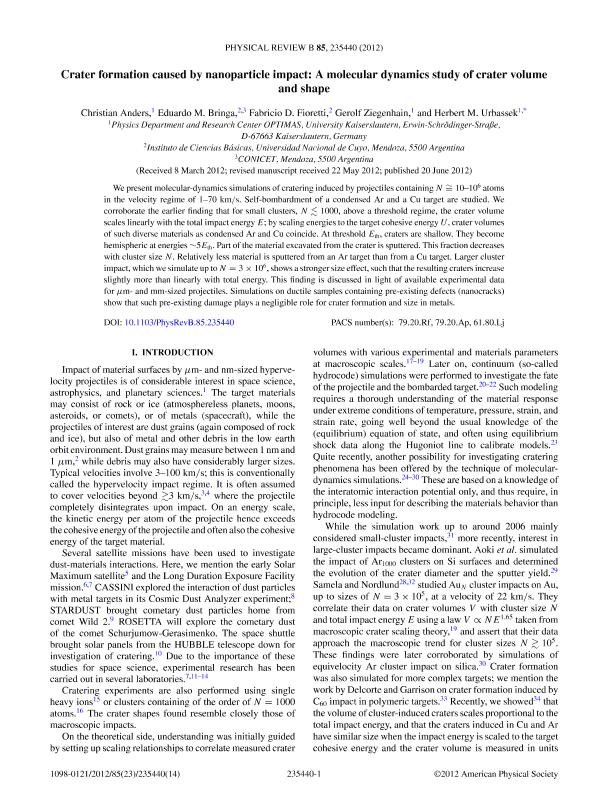Mostrar el registro sencillo del ítem
dc.contributor.author
Anders, Christian

dc.contributor.author
Bringa, Eduardo Marcial

dc.contributor.author
Fioretti, Fabricio D.

dc.contributor.author
Ziegenhain, Gerolf

dc.contributor.author
Urbassek, Herbert M.

dc.date.available
2017-06-14T18:00:45Z
dc.date.issued
2012-06-20
dc.identifier.citation
Anders, Christian; Bringa, Eduardo Marcial; Fioretti, Fabricio D.; Ziegenhain, Gerolf; Urbassek, Herbert M.; Crater formation caused by nanoparticle impact: A molecular dynamics study of crater volume and shape; American Physical Society; Physical Review B: Condensed Matter And Materials Physics; 85; 23; 20-6-2012; 1-14; 235440
dc.identifier.issn
1098-0121
dc.identifier.uri
http://hdl.handle.net/11336/18164
dc.description.abstract
We present molecular-dynamics simulations of cratering induced by projectiles containing N ∼= 10–106 atoms in the velocity regime of 1–70 km/s. Self-bombardment of a condensed Ar and a Cu target are studied. We corroborate the earlier finding that for small clusters, N 1000, above a threshold regime, the crater volume scales linearly with the total impact energy E; by scaling energies to the target cohesive energy U, crater volumes of such diverse materials as condensed Ar and Cu coincide. At threshold Eth, craters are shallow. They become hemispheric at energies ∼5Eth. Part of the material excavated from the crater is sputtered. This fraction decreases with cluster size N. Relatively less material is sputtered from an Ar target than from a Cu target. Larger cluster impact, which we simulate up to N = 3 × 106, shows a stronger size effect, such that the resulting craters increase slightly more than linearly with total energy. This finding is discussed in light of available experimental data for μm- and mm-sized projectiles. Simulations on ductile samples containing pre-existing defects (nanocracks) show that such pre-existing damage plays a negligible role for crater formation and size in metals.
dc.format
application/pdf
dc.language.iso
eng
dc.publisher
American Physical Society

dc.rights
info:eu-repo/semantics/openAccess
dc.rights.uri
https://creativecommons.org/licenses/by-nc-sa/2.5/ar/
dc.subject
Nanocracks
dc.subject
Crater Formation
dc.subject.classification
Física de los Materiales Condensados

dc.subject.classification
Ciencias Físicas

dc.subject.classification
CIENCIAS NATURALES Y EXACTAS

dc.title
Crater formation caused by nanoparticle impact: A molecular dynamics study of crater volume and shape
dc.type
info:eu-repo/semantics/article
dc.type
info:ar-repo/semantics/artículo
dc.type
info:eu-repo/semantics/publishedVersion
dc.date.updated
2017-04-07T13:40:19Z
dc.journal.volume
85
dc.journal.number
23
dc.journal.pagination
1-14; 235440
dc.journal.pais
Estados Unidos

dc.journal.ciudad
Nueva York
dc.description.fil
Fil: Anders, Christian. University Kaiserslautern. Physics Department and Research Center OPTIMAS; Alemania
dc.description.fil
Fil: Bringa, Eduardo Marcial. Universidad Nacional de Cuyo. Facultad de Ciencias Exactas y Naturales; Argentina. Consejo Nacional de Investigaciones Científicas y Técnicas. Centro Científico Tecnológico Conicet - Mendoza; Argentina
dc.description.fil
Fil: Fioretti, Fabricio D.. Universidad Nacional de Cuyo. Facultad de Ciencias Exactas y Naturales; Argentina
dc.description.fil
Fil: Ziegenhain, Gerolf. University Kaiserslautern. Physics Department and Research Center OPTIMAS; Alemania
dc.description.fil
Fil: Urbassek, Herbert M.. University Kaiserslautern. Physics Department and Research Center OPTIMAS; Alemania
dc.journal.title
Physical Review B: Condensed Matter And Materials Physics

dc.relation.alternativeid
info:eu-repo/semantics/altIdentifier/doi/http://dx.doi.org/10.1103/PhysRevB.85.235440
dc.relation.alternativeid
info:eu-repo/semantics/altIdentifier/url/https://journals.aps.org/prb/abstract/10.1103/PhysRevB.85.235440
Archivos asociados
